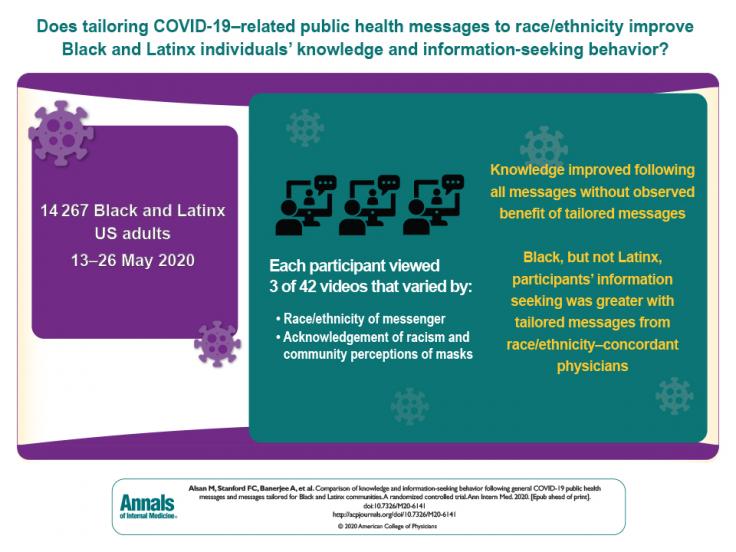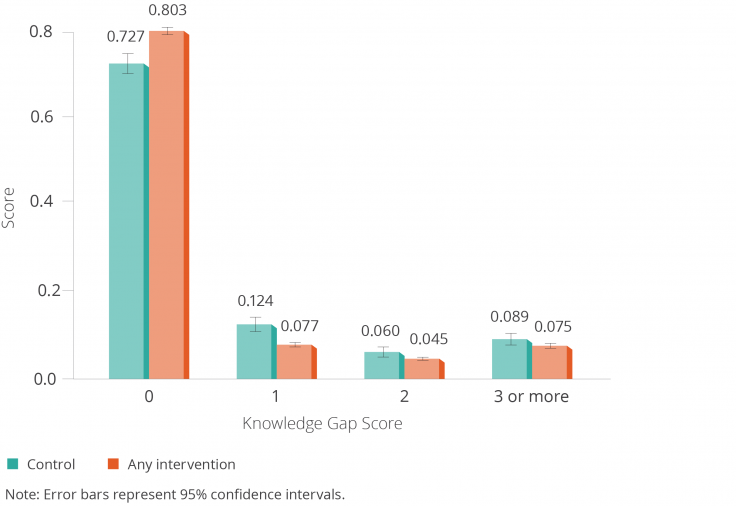General and Tailored Covid-19 Health Messaging to Minorities in the United States
Project Summary
Black and Latinx communities have been disproportionately affected by Covid-19. The disparities in prevalence and health outcomes reflect a complex set of factors including systemic racism, inequality in access to health services, discrepancies in educational opportunities, and occupational differences. There are also knowledge gaps, perhaps reflecting the lack of effort to design Covid-19 public health messaging with minority communities in mind. White experts deliver most messages, and they rarely address these communities’ specific concerns.
Motivated by this issue, the research team worked with the Center for Diversity and Inclusion (CDI) of Massachusetts General Hospital (MGH), and over 40 physicians from MGH and the Lynn Community Health Center, to form a “Covid-19 Messaging Working Group” and develop Covid-19 video health messages that would address the specific concerns of these communities. To evaluate these messages’ effectiveness at increasing Covid-19 knowledge and spurring health information-seeking behaviors, the team conducted an online evaluation involving approximately 15,000 Black and Latinx individuals. Some participants randomly received these physician-delivered video messages on Covid-19. For those who received video messages, further randomization made it possible to assess whether race or ethnic concordance (i.e. where the physicians’ race matched that of the respondent), acknowledgments of injustice, or information on social perceptions would make the message more effective, as measured by a reduced knowledge gap and change in information-seeking behaviors.
The primary outcomes were Covid-19 related knowledge as well as health information-seeking behavior. To determine knowledge, participants were asked about symptoms, transmission, and best practices such as social distancing and mask-wearing. To determine health information seeking behaviors, participants were asked about their interest in a variety of weblinks about social distancing and hygiene, health resources, and homemade protective face coverings. The impact on health information-seeking is determined by the number of links for which participants expressed interest.
What have we learned?
Public health messaging, as transmitted through physicians, are effective for reducing knowledge gaps about Covid-19.
The results show that public health messaging is a strong lever for ameliorating knowledge gaps, and physicians are a great vehicle for these messages. Regardless of physician race, public health messages directly improved knowledge of symptoms, asymptomatic transmission, and preventative practices for both Black and Latinx respondents.
Race concordant messaging was particularly effective for improving health information-seeking behavior for Black respondents.
For Black respondents receiving video messages, messages delivered by Black physicians spurred an increased interest in health information-seeking, such as interest in watching tutorial videos on making homemade masks and seeking additional health resources about Covid-19. This suggests the importance of race concordance in spurring these behaviors.
Public health video messages
Respondents who received public health messaging videos saw a sequence of three videos, covering, respectively, (1) major symptoms and preventative practices, (2) advice about social distancing, and (3) information about mask wearing. Randomized variants of this standard sequence included acknowledgements of injustice and/or information about perceptions of mask wearing in the community.
The race of the physician was kept fixed throughout the video sequence, where respondents were randomized to see messages from a race concordant (Black or Latinx) or discordant (White) physician.
As an example, we show a standard sequence of messages by Black doctors. Such a sequence closed knowledge gaps relative to no videos, and furthermore encouraged health information-seeking behaviors relative to race discordant doctors.
Video 1: Symptoms and Transmission
Covid-19 is a new virus that can infect the respiratory tract and lungs. Although many people who get sick from Covid will get better, some people who get it become very ill and some even die.
Although there’s no cure, there are ways medical professionals have found to protect you and your community from Covid. I hope that this message can give you information that will help you protect you or someone you love from Covid infection.
First, I would like to tell you about the symptoms of Covid-19.
The most common symptoms of Covid-19 are cough, fever, and trouble breathing. Another odd symptom some people have is loss of taste or smell.
A large number of people who have Covid-19 actually don’t show any symptoms at all. Unfortunately, people can still spread the disease to others even with no symptoms.
The next video will provide you with more information on how you can protect yourself and others.
Video 2: Social Distancing
The absolute most important thing is for people to remember is to be six feet away from every other human being. What does that mean? Whether you're outside, whether you’re shopping, whether you have to go to the pharmacy or grocery store to get the absolutely essential supplies, make sure that you are staying six feet away from the next person.
Ensure that you know exactly where your hands are, what you touched and make sure you’re washing them or using hand sanitizer on a regular basis. When you come home make sure you disinfect everything that has touched something else.
Video 3: Mask wearing
Wearing a mask is a key way to prevent the spread of Covid-19. You are not just protecting yourself but also your grandma and your community, just in case you have Covid-19 but don’t know it.
Even if wearing a mask may sometimes put you in a difficult situation, it is important to protect you and the community from Covid-19 disease.
As medical professionals, I am committed to delivering the best care I can to every patient. My goal is to make sure that you and everyone you love survives this Covid-19 pandemic. Thank you for listening to these messages.
See all public health videos used in this project on YouTube
Research Results
View the full results on Annals of Internal Medicine.


Intervention Details
A control group was guided to the outcomes about knowledge and intended behaviors without receiving any public health messaging. Within the treatment group, participants were either guided to a standard sequence of messages or variants on the standard sequence of messages that included acknowledgements of injustice or inequality, or social perceptions about mask wearing. For each such combination, the messages were either delivered by a race-concordant or discordant physician.
Some treatment respondents were furthermore shown Dr. Deborah Birx delivering the CDC social distancing message from the White House instead of a physician, to find possible contrast in the response to this messenger.
| All treatments receive basic information+ | Includes social perceptions of mask wearing | No social perceptions of mask wearing |
|---|---|---|
| "Standard sequence" messages about symptoms and social distancing | Concordant/Discordant | Concordant/Discordant |
| Sequence with acknowledgement about economic inequality | Concordant/Discordant | Concordant/Discordant |
| Sequence with acknowledgement specific to race | Concordant/Discordant | Concordant/Discordant |
| Sequence with Dr. Birx delivered message about social distancing | Concordant/Discordant | Concordant/Discordant |